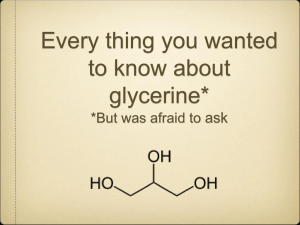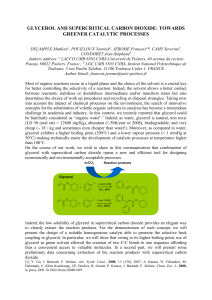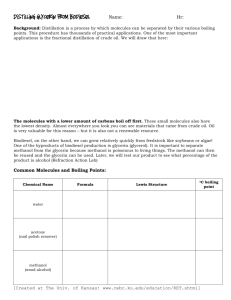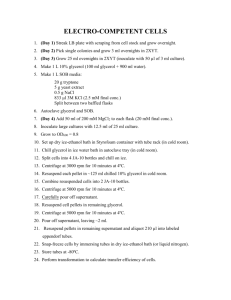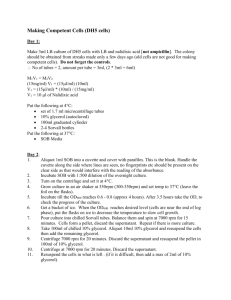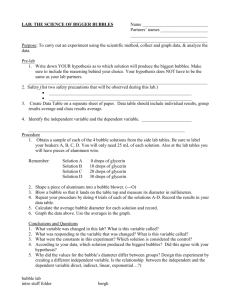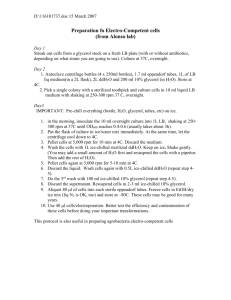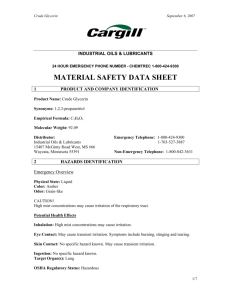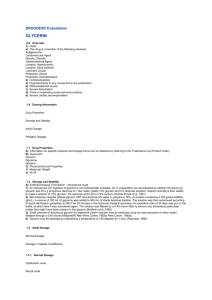Glycerine Properties & Uses: Data Sheet
advertisement
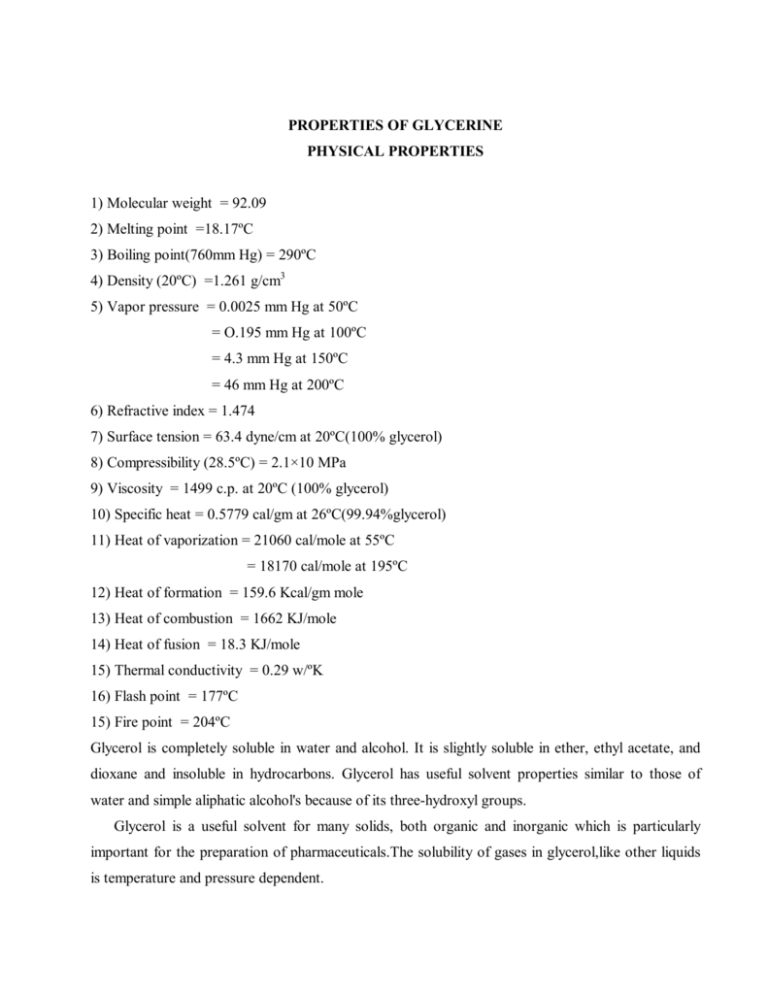
PROPERTIES OF GLYCERINE PHYSICAL PROPERTIES 1) Molecular weight = 92.09 2) Melting point =18.17ºC 3) Boiling point(760mm Hg) = 290ºC 4) Density (20ºC) =1.261 g/cm3 5) Vapor pressure = 0.0025 mm Hg at 50ºC = O.195 mm Hg at 100ºC = 4.3 mm Hg at 150ºC = 46 mm Hg at 200ºC 6) Refractive index = 1.474 7) Surface tension = 63.4 dyne/cm at 20ºC(100% glycerol) 8) Compressibility (28.5ºC) = 2.1×10 MPa 9) Viscosity = 1499 c.p. at 20ºC (100% glycerol) 10) Specific heat = 0.5779 cal/gm at 26ºC(99.94%glycerol) 11) Heat of vaporization = 21060 cal/mole at 55ºC = 18170 cal/mole at 195ºC 12) Heat of formation = 159.6 Kcal/gm mole 13) Heat of combustion = 1662 KJ/mole 14) Heat of fusion = 18.3 KJ/mole 15) Thermal conductivity = 0.29 w/ºK 16) Flash point = 177ºC 15) Fire point = 204ºC Glycerol is completely soluble in water and alcohol. It is slightly soluble in ether, ethyl acetate, and dioxane and insoluble in hydrocarbons. Glycerol has useful solvent properties similar to those of water and simple aliphatic alcohol's because of its three-hydroxyl groups. Glycerol is a useful solvent for many solids, both organic and inorganic which is particularly important for the preparation of pharmaceuticals.The solubility of gases in glycerol,like other liquids is temperature and pressure dependent. CHEMICAL PROPERTIES Glycerol is a reactive molecule that undergoes all the usual reactions of alcohols. The two terminal primary hydroxyl groups are more reactive than the internal secondary hydroxyl group. Under neutral or alkaline conditions, glycerol can be heated to 250ºC without formation of acrolein. Reactions with glycerol are therefore best carried out under alkaline or neutral conditions at 180ºC, alkaline glycerol begins to dehydrate forming ether-linked polyglycerols. At room temperature glycerol rapidly absorbs water. When dilute it is attacked by microorganism. On oxidation, glycerol yields variety of product depending upon the reaction conditions. By the use of mild oxidizing agent it is possible to oxidize only one hydroxyl group to yield Glyceraldehyde.These compounds may be considered very simple aldose and simplest ketoses respectively and mixture of two compounds obtained from glycerol as well as glyceraldehyde has been Called glycerose. Nitric acid converts glycerol to glyceric acid CH2CHCHOHCOOH melting at 134-135ºC when pure, but usually obtained as syrupy. Oily liquid soluble in water and alcohol, but insoluble in ether. Some industrially important reaction products of glycerol include: 1) Mono-,di-,and tri esters of inorganic and organic acids 2) Mono and diglyceride of fatty acids formed by transesterification of triglycerides(from fats) 3) Aliphatic and aromatic esters formed by reactions with alkylating agents respectively 4) Polyglycerols formed by the intermolecular alienation of water with alkaline catalyst 5) Cyclic 1,2-or 1,3-acetals or ketals formed by the reaction with aldehyde or ketons respectively USES OF GLYCERINE: Glycerin has a role in virtually every industry. The largest single user in alkyl resin industry. Cellophane manufacture in which glycerin is a plasticiser is the next largest. The manufacture of the glycerol nitrate is also important consumer of glycerin. FOOD: Glycerin as a food is easily digested and non-toxic and it's metabolism places it with the carbohydrates, though it is present in combined form in all vegetable and animal fats. For product used in food and food wrappings where direct contact with the user is involved, non-toxicity is major requirement. Since 1959,glycerine is recognized as safe by food and drug administration. In flavoring and coloring product it acts as a solvent and its viscosity lends body to the product. In candies and icings glycerin prevents crystallization of sugar. Glycerin is useful as a solvent in breaking down of cells to extract soluble proteins, since it tends to form stable association with proteins liberated, probably because of the presence of hydroxyl group in glycerol molecule, however concentration of glycerol solution employed should not exceed 85%. DRUGS AND COSMETICS: In drugs and the medicine glycerin is an ingredient of many tinctures and elixirs and as a glyceride of starch is used in jellies and ointments. It is employed in the cough medicine and anesthetics such as glycerin phenol solution, for ear treatment and in bacteriological culture media. Its derivatives are used in tranquilizers and nitroglycerine is a vasodilator in coronary spasm. In cosmetics glycerin is used in many creams and lotion to keep the skin soft and replace skin moisture. It is the basic media in which toothpaste is formed, maintaining desired smoothness and viscosity and lending a shine to paste. TOBACCO: In processing tobacco, glycerin is important part of casing solution sprayed on tobacco before leaves are shredded and packed. Along with other flavoring agents, it is applied at a rate of about 3% of the weight of the tobacco to prevent the leaves from becoming friable and thus crumbling during processing, by remaining in the tobacco, glycerine helps to retain moisture and thus prevent drying out of tobacco. It is also used in the processing of chewing tobacco to add sweetness and prevent dehydration and as a plasticiser in cigarette papers. WRAPPING AND PACKAGING MATERIAL: Heat casings and special types of papers, such as glassine and grease proof paper, need a plasticisers to give them pliability and toughness, as such glycerin is completely compatible with base material used, is absorbed by them and does not crystallize and volatilize appreciably. LUBRICANTS: Glycerin can be used as a lubricant in places where oil can fail. It is recommended for oxygen compressor because it is more resistant to oxidation then mineral oils. It is also to lubricate pumps and bearings exposed to fluids such as gasoline and benzene, which would dissolve oil type, lubricate. In food pharmaceutical and cosmetic manufacture where there is contact with lubricant, glycerin may used to replace oils. Glycerin is often used as a lubricant because of it’s high viscosity and ability to remain fluid at low temperatures make it valuable without modification.To increase its lubricating power,finely divided graphite may be dispersed in it.Its viscosity may be decreased by addition of water,alcohols and glycols and increased with polymerization or mixing with starch-pastes of such composition may be used in packing pipe joints,in gas lines or similar application.For use in high pressure gases and valves,soaps are added to glycerin to increase its viscosity and increase its lubricating ability mixture of glycerin and glucose is employed as a non-drying lubricant in the die-pressing of metals.In textile indusrty,glycerine is frequently used in connection with so called ‘textile oils’ in spinning,knitting and weaving operations. URETHAM-POLYMERS: An important and recent use of glycerin is fundamental building block in poly-ethers for urethanpolymers.In this use it is the initiator to which propylene oxide,alone or with ethylene oxide is added to produce trifunctional polymer which on reaction with disocyanates,produce flexible urethane foams.Glycerine based poly-ethers have found some use too in rigid urethane foams. GASKET AND CORK PRODUCT: Sheets and gaskets made with ground cork and glue require plasticisers, which has some humectant action in order that they may be pliable and tough. Glycerin is used here because of its lower vapor pressure, not readily absorbed by the corks and compatible with glue. With crown sealers and cork stoppers, which come into contact with foods, it fulfills additional requirements of non-toxicity. MISCELLANEOUS USES: Glycerin used in cement compounds, lubricants and pressure media. It is also used in embalming fluids, masking and shielding compounds. Soldering compound and compasses,cleaning material such as soap and detergents and wetting agents,emulsifiers and the industrial skin protective, asphalt ceramics, photographic products,leather and wood treatments and adhesives.

